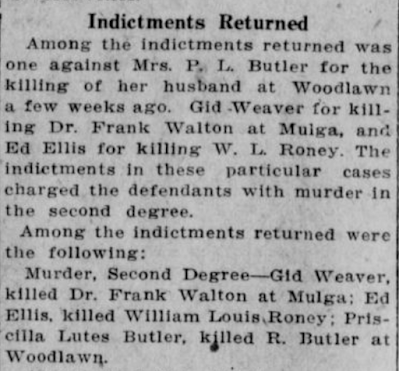I'm still making my way through the World War II issues of the Gadsden Times saved by paternal grandmother Rosa Mae Wright. Here's another recently found item; I've piled up a number of others and have many more issues to examine. You are in for some real treats.
This item describes the violent death of a Mrs. Laura Ball Blue at her home in Bessemer on May 23, 1943. She was almost decapitated by a "heavy charge" from a shotgun, which was found in another room. As the first article notes, her husband J. Howard Blue was about to be charged with first degree murder.
Shortly after 9:30 the previous night the coroner received a call from the husband, a physician, and when he arrived at the house found Mrs. Blue's body and an incoherent Dr. Blue. His wife had apparently just come into the house from the garage; car keys were still in her hand. Both of their sons were away from home at the time.
Blue was a "widely known Bessemer physician" who specialized in eye, ear, nose and throat disorders. He was freed on bond after a July 7 preliminary hearing, but finally indicted for first degree murder by a grand jury on August 6 and returned to jail without bond.
The December 25, 1943, issue of the Journal of the American Medical Association picks up the story:
"Physician Sentenced on Murder Charge.— Dr. James Howard Blue, Bessemer, was found guilty by a jury of murder in the second degree and sentenced to fifty years' imprisonment, newspapers reported November 17. Attorneys for the defense announced that motion for a new trial would be filed. At the physician's first trial last September a mistrial was declared. Dr. Blue was charged with the shooting of his wife, May 23."
I've yet to determine exactly what happened after this trial, but I've picked up the story of Dr. Blue in the early 1950s. He is listed in the 1951 Bessemer city directory under "Physicians and Surgeons" with an office at 1828 3rd Avenue, phone R207. According to Google Maps that address is in the same block as the Bright Star Restaurant. By publication of the 1953 Bessemer city directory, we find this entry: "Denzil R. Blue--ear, eye, nose & throat specialist, wife Lola M. Office at 1828 3rd Avenue, home in Lakewood Estates".
Denzil was apparently a nephew of James Howard Blue; the Blue family seems to have had several physicians. James Howard had died on March 10, 1953, and is buried in Elmwood Cemetery in Birmingham. Poor Laura Blue was also buried in Elmwood. Her husband remarried in 1950 to Vera Tucker; he was her third husband. She, too, is resting in Elmwood.
As the second article notes, Blue contended that first wife Laura killed herself.
UPDATE 27 SEPTEMBER 1925
I've found another article from the Gadsden Times dated 17 September 1943 that has some interesting new information. See below.
UPDATE 18 October 1925
I added yet another article from the Gadsden Times 15 September 1943. A witness, another physician, testified to a 10 year-old threat by Dr. Blue to kill his wife.
Gadsden Times 15 September 1943








































